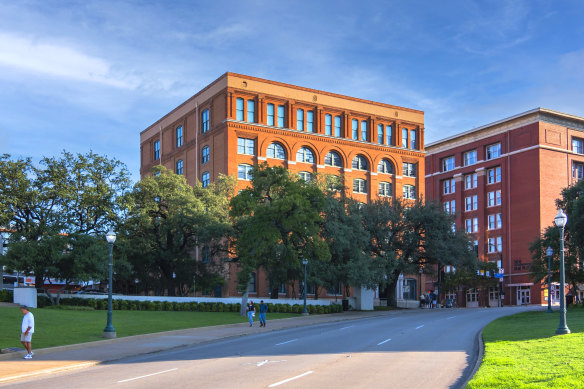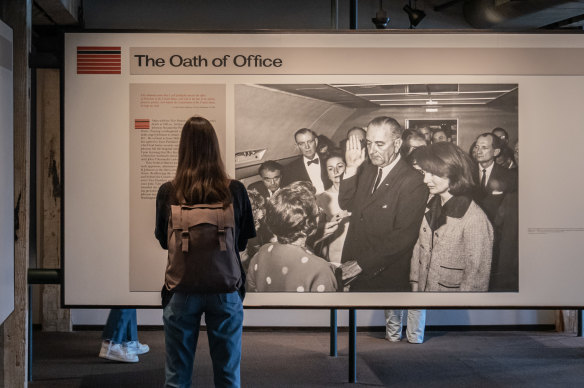Artefacts surrounding JFK’s death go on display for the first time
The traffic is slow on Elm Street today, which is just as well, for a man is standing in the middle of the road posing for a photo. He turns towards the former Texas School Book Depository building on Dealey Plaza and points up at the sixth floor’s corner window. It was here, on November 22, 1963, that Lee Harvey Oswald crouched down, lifted his rifle to the sill and fired the shots that killed American president John F. Kennedy.
I can almost hear the barrel’s recoil and history’s echo as I peer down at the placid scene from my lookout on the depository’s empty top floor. Far below, the man – a fellow tourist, I presume – grins at his companion as she snaps pictures from the grassed verge. The white “X” taped onto the asphalt beneath his feet is hefted with import: it pinpoints not only the site of Kennedy’s assassination, but the locus of six decades of morbid fascination, wild conspiracy and an abiding, collective grief.

X marks the spot – the road below The Sixth Floor Museum at Dealey Plaza, Dallas, Texas.
Located on the Dealey Plaza site where a wagon shop once stood, the seven-storey, red-brick depository building has since been restored to its 1901 origins. Inside, cardboard boxes stacked around the glassed-off “sniper’s perch” attest to its function as a depository when Oswald started working here just a few weeks before the assassination. In the aftermath, the building was acquired by Dallas County, and in 1989 the Sixth Floor Museum was opened here as both memorial to a fallen president and repository of a nation’s socio-political history.
Now, as the US commemorates the 60th anniversary of that notorious event, previously unseen artefacts have been included in the “Two Days in Texas” exhibition (on until June 2024). Among them are a handwritten letter in which Kennedy’s wife, Jackie, asks Nobel laureate John Steinbeck to write her late husband’s biography (he declined), and the now-bloodstained shirt worn by Dr Robert McClelland when he treated the mortally wounded Kennedy at Parkland Memorial Hospital.
Notwithstanding such mementoes – and the tourist posing on Elm Street – this is not a voyeuristic experience. Though visitors are immediately drawn to the glassed off corner window and replica of the Mannlicher-Carcano rifle that felled JFK, it’s the distillation of stories in apparently minor objects that has lured me back for a second visit: Oswald’s 14-karat gold wedding band, stamped with a Soviet insignia; the polished silverware and white crockery embossed with delicate gold fluorescence that awaited the Kennedys at the luncheon to which they were headed.

A museum exhibit – Lyndon B. Johnson is sworn in as US President with JFK’s widow, Jackie Kennedy, at his side.
Intriguing, too, is the parsing of the political milieu of 1963. The assassination occurred during the Cold War, the space race and the growth of the American civil rights movement. Conspiracies about additional assassins are omnipresent: though the Warren Report concluded in the affirmative, further reflection is prompted by relics belonging to Jack Ruby, who helped cement those conspiracies when he inexplicably shot Oswald dead in the basement of the Dallas police headquarters two days later. Here is the grey fedora he was wearing; there is the note he passed to his lawyer during his subsequent trial: “Also I was wearing a hat so how could he tell the expression on my face?” he’d scribbled in pencil.
The media’s role is recalled in the hulking Associated Press teletype machine, which carried news of the incident across the world, and which chronicles an era that long predates the relentless modern-day news cycle. There are Leica, Polaroid and Yashica cameras which captured the day’s still images; but it’s Abraham Zapruder’s replica Bell and Howell home movie camera that tells the unvarnished story. Filming the motorcade as it reached the spot on Elm Street, now marked with an X, the clothing manufacturer unwittingly captured a scene that would be etched forever on the nation’s psyche.
THE DETAILS
Visit
The Two Days in Texas exhibition runs until June 16, 2024. Access is included in museum admission, from $US22 ($34) for an adult. The museum is closed on Mondays and Tuesdays. See jfk.org
The writer visited the exhibition as a guest of the Sixth Floor Museum.
Sign up for the Traveller Deals newsletter
Get exclusive travel deals delivered straight to your inbox. Sign up now.